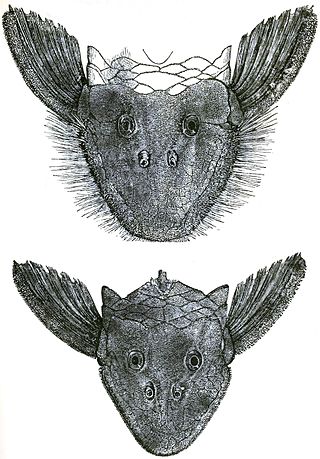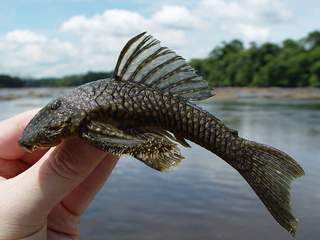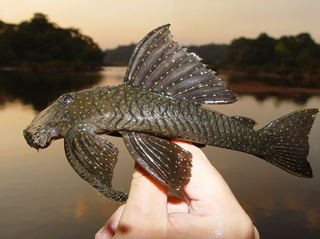
Pseudancistrus is a genus of suckermouth armored catfishes native to South America.
Pseudoqolus koko is a species of catfish in the family Loricariidae and the only species in the genus Pseudoqolus. It is a freshwater fish native to South America, where it occurs in the Maroni basin. It is usually found on or near stony substrates in the main river channel at a depth of around 2 m. The species has been collected alongside multiple other loricariid species, including Hemiancistrus medians, Peckoltia otali, Pseudancistrus barbatus, Harttia guianensis, Loricaria cataphracta, and Rineloricaria stewarti. It is noted that the gut contents of one specimen of this species contained primarily spicules and sponge fragments, indicating that it may feed on freshwater sponges. The species reaches 9 cm SL.
Pseudancistrus asurini is a species of catfish in the family Loricariidae. It is native to South America, where it occurs in the Xingu River basin in the state of Pará in Brazil. The species reaches 19.6 cm SL. Its specific epithet, asurini, refers to the Asurini people, native speakers of the Xingu Asurini language, who inhabit the Xingu basin near Altamira. It was described in 2015 by Gabriel S. C. Silva, Fábio F. Roxo, and Claudio Oliveira alongside the related species Pseudancistrus kayabi from the Tapajós basin.
Pseudancistrus coquenani is a species of catfish in the family Loricariidae. It is native to South America, where it occurs in the basin of the Cuquenán River, which itself is part of the upper Caroní River drainage in Venezuela. The species reaches 8.1 cm SL, and it is named for the river basin in which it is found.

Pseudancistrus corantijniensis is a species of catfish in the family Loricariidae. It is native to South America, where it occurs in the Courantyne River in Suriname. The species reaches 17.9 cm SL, and it is named for the Courantyne, which is its only known habitat.

Pseudancistrus depressus is a species of catfish in the family Loricariidae. It is a freshwater fish native to South America, where it is known only from Suriname, reportedly occurring in the Coppename River. The species reaches 13 cm in total length.
Pseudancistrus guentheri is a species of catfish in the family Loricariidae. It is native to South America, where it was initially collected from an unknown locality in Guyana, although it has subsequently been reported from the confluence of the Mazaruni River and the Cuyuni River near the village of Kartabo. The species reaches 12 cm (4.7 in) in length.
Pseudancistrus kwinti is a species of catfish in the family Loricariidae. It is native to South America, where it occurs in the Coppename River in Suriname. The species reaches 9.4 cm (3.7 in) SL. P. kwinti was described in 2010 by Phil Willink of the Field Museum of Natural History, Jan Mol of Anton de Kom University of Suriname, and Barry Chernoff of Wesleyan University on the basis of distinctive morphology and coloration.

Pseudancistrus zawadzkii is a species of catfish in the family Loricariidae. It is native to South America, where it occurs in the Tapajós basin, including the Tracuá River, in Brazil. It is typically found in areas with clear water, rocky outcrops, small waterfalls, and a substrate of rocks and sand. The species reaches 12.9 cm SL.

Pseudancistrus nigrescens is a species of catfish in the family Loricariidae. It is native to South America, where it occurs in the upper Potaro River basin in Guyana. The species reaches 18.2 cm in total length.
Pseudancistrus orinoco is a species of catfish in the family Loricariidae. It is native to South America, where it occurs in the Orinoco basin. The species reaches 10 cm in total length.
Pseudancistrus yekuana is a species of catfish in the family Loricariidae.
Pseudancistrus pectegenitor is a species of catfish in the family Loricariidae. It is native to South America, where it occurs in the main channel of the Orinoco near the mouth of the Ventuari River, as well as in the Casiquiare. The species is usually found in areas with flowing water near large rocky outcrops. It reaches 24.2 cm SL.
'Pseudancistrus' megacephalus is a species of catfish in the family Loricariidae. It is of uncertain and disputed classification.
Pseudancistrus papariae is a species of catfish in the family Loricariidae. It is native to South America, where it occurs in Lake Papari and the Jaguaribe River basin in Brazil. The species reaches 15.3 cm SL.
Pseudancistrus reus is a species of catfish in the family Loricariidae. It is native to South America, where it occurs in the Caroní River in Venezuela. It is typically found in presumably blackwater environments with low conductivity and a moderate current. The species reaches 7.7 cm SL. Its specific epithet, reus, is derived from Latin and translates to "prisoner", alluding to the species' barred patterning which resembles a stereotypical prison uniform.
Hypostomus watwata, commonly known as the armored catfish, is a species of catfish in the family Loricariidae. It is native to South America, where it occurs in the coastal drainages of Guyana and French Guiana, ranging from the Oyapock to the Demerara River. It is an introduced species in Hawaii.
Hypostomus papariae is a species of catfish in the family Loricariidae. It is native to South America, where it is believed to occur in the Potenji River basin in the state of Rio Grande do Norte in Brazil. The species reaches 11.4 cm in total length and is believed to be a facultative air-breather. The specific epithet papariae likely refers to Lake Papari, which the species is known from, an etymology shared with another loricariid species, Pseudancistrus papariae.

Guyanancistrus longispinis is a species of catfish in the family Loricariidae that is of disputed classification. It is native to South America, where it occurs in the Oyapock basin in French Guiana. It is typically seen in shallow rapids with rocky substrates and moderate levels of illumination. It is known to occur alongside the species Guyanancistrus brevispinis, Harttia fowleri, and Crenicichla ternetzi, as well as members of the genus Ancistrus. The species reaches 10.4 cm in standard length and may be a facultative air-breather.

Guyanancistrus niger is a species of catfish in the family Loricariidae that is of disputed classification. It is native to South America, where it occurs in the Oyapock basin in French Guiana. Though reportedly uncommon, it is typically seen in rapids where the species Pseudancistrus barbatus is also present, although the ecological relationship between the two is not known. The species reaches 15.9 cm in standard length, although it has been reported to reach 25.4 cm, and it may be a facultative air-breather.





